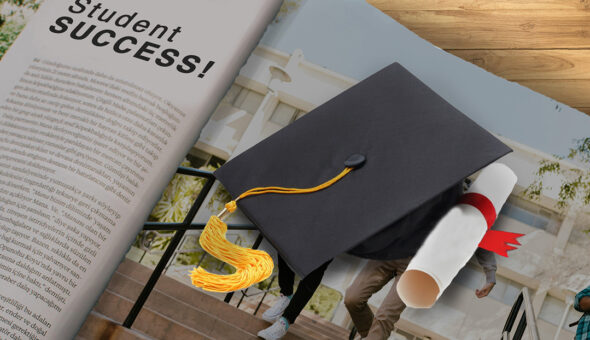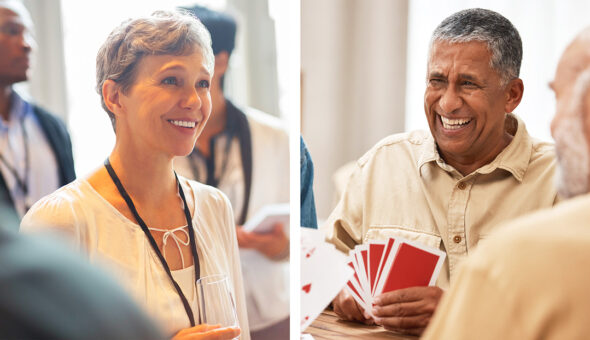Higher ed marketers have embraced the trend of an annual day of giving in recent years. And with Giving Tuesday right around the corner, colleges and universities have a golden opportunity to raise critical funds in a year that have many higher ed institutions facing tough financial situations. In the latest Higher Voltage podcast, we discuss the state of institutional giving in 2020 in higher ed, and the ways that colleges and universities will leverage Giving Tuesday to create their own dedicated days of giving before the fiscal year is out.
Specifically, we discuss text banking, personalized video, analytics, and the latest in giving strategy, and the ways in which giving campaigns create valuable data-mining opportunities. Plus, with guests from schools both large and small, we analyze the different ways schools of different sizes approach institutional giving, and how those teams are structured.
Our Guests:
- Brittany Shaff is the assistant vice president for digital engagement & philanthropic giving at the University of Miami. Her team supports all schools and units as well as the medical units under the University and University of Miami Health System.
- Tim O’Keeffe is the senior director for marketing and analytics at Hamilton College. At Hamilton, Tim provides colleagues with actionable data to shape the Communications and Marketing Office’s content strategy.
Our Host:
Heather Dotchel is the host of Higher Voltage. She is a Philadelphia-based higher ed marketing professional who most recently led two area colleges as their chief marketing officer.
Read the complete transcript:
Heather Dotchel:
Welcome to Higher Voltage, a podcast that explores the ins and outs of higher education marketing and touches on all aspects of the business of higher education. My name is Heather Dotchel. You’ll have most recently encountered me leading the marketing and communications teams at two Philadelphia-area colleges. With Giving Tuesday just around the corner, we wanted to talk about the state of institutional giving in 2020 and the ways that colleges and universities will leverage Giving Tuesday to create their own dedicated days of giving before the fiscal year is out.
Heather Dotchel:
Both of our guests have just recently completed successful days of giving at the respective institutions. First up we have Brittany Shaff. Brittany Shaff is the assistant vice president for Digital Engagement and Philanthropic Giving at the University of Miami. Her team supports all schools and units as well as the medical units at the university and its health system. Prior to working at Miami, she’s been in various marketing and analytics positions in higher education, including at Santa Clara University, Towson University and John Hopkins University.
Heather Dotchel:
Tim O’Keeffe is the senior director for marketing and analytics at Hamilton College. Tim provides colleagues with actionable data to shape the communications and marketing offices content strategy. Previously, Tim worked in digital communications at Colgate University and spent 20 years as a working journalist, including being the first online editor at The Indianapolis Star newspaper. We are excited to have you both. Let’s get started with the hard numbers question. What did you invest in promoting your day of giving and what was your total raised? Brittany, care to start us off with this?
Brittany Shaff:
Sure. Our total investment in our day of giving was around $6,000 and our total raised for our day of giving exceeded $1.5 million.
Heather Dotchel:
That’s impressive. Tim, how about you?
Tim O’Keeffe:
This giving day for us was a little bit smaller scale, but we don’t have a… we’re a smaller shop than Brittany and so we were targeting donors. We had 3,518 donors contribute and participate and we raised $1.7 billion on the day. For us the expenditure was a lot of sweat equity primarily, and our print pieces that cost around $10,000, and then for me on the social side about just $350, was what we spent.
Heather Dotchel:
Excellent. Well, congratulations to you both. One of the reasons I asked both of you on here was because your institutions are very different sized and I think it will be interesting to see the contrast between the two and helpful for our audience to also kind of pick which ones match up most closely with their needs. Tim, what was the backbone of your strategy to raise awareness and convert that knowledge to gifts?
Tim O’Keeffe:
Right. I think for us this time around, to be honest it was an intensified timeline because frankly we [inaudible 00:03:05] the pandemic and we were worried about things happening on campus that would delay this and kind of blow this up, but externally and what we were trying to do was this was one of our earliest give days ever and we were trying to front-load support for our Hamilton Fund and we were trying to reassure our alumni and others that even though our rules have changed here on campus, that we were still Hamilton and that’s where we landed on the Hamilton at heart sort of theme for the give day itself.
Heather Dotchel:
Brittany, what was your backbone?
Brittany Shaff:
Great question. Ours was around just straight digital lead generation. Everything we did was with a lead in B2C or a business to consumer kind of approach. Consumer here, we would really call constituent, but for lack of a better term, a B2C approach. We really focused on brand awareness, engagement, and then digital conversions when it came to giving. We started about two and a half weeks prior to our giving day. We did not use print at all and the $6,000 cost was generally spent… about 90% of it was spent actually on digital advertisements, and then tracking our conversion kind of practices.
Brittany Shaff:
We did all of our content creation in-house, so we had over 500 different content pieces for the day leading up to and on the day, as well as following the giving day, that does not include roughly 1500 personalized video messages that we use to air video platform system but that’s kind of what we focused on as our backbone.
Heather Dotchel:
Before we dig into some more details, let’s take a quick break to say that we are brought to you by eCity Interactive. For more than 20 years eCity has been creating marketing strategies, websites, and digital experiences for higher ed institutions, large and small. Inspired by challenge and proven by results, eCity can help you solve the greatest challenges facing your institution today.
Heather Dotchel:
Brittany, let’s dig in a little further. I know that you have a self-sufficient unit that has communication skills embedded in it. Can you explain what your team looks like and how you work with the central communications office, if at all?
Brittany Shaff:
Yeah. Great question and happy to. As you outlined in the beginning of the podcast, I have three teams actually that support my office, that roll up to me. First one would be a Philanthropic Giving team, which is almost like an omni-channel marketing team that supports the school’s [inaudible 00:05:30]. They’re really focused on engagement and solicitations for the schools and colleges. At the same time, I have a similar team that supports the medical institution and the health system. That team is really focused on grateful patient acquisition, retention of donors to medicine. And then the third team is a digital engagement team.
Brittany Shaff:
For this purposes, we might just refer to it as digital marketing and that supports both of those other two keys. I’m really fortunate that we actually have a central communication team within our development division. In addition to that, we have a university communication team and both of them are central and supporting our initiatives. For instance, our university communication team assisted with creating one of our large-scale giving day videos. We do partner with both of those two teams when it comes to giving days or Giving Tuesday, for instance.
Tim O’Keeffe:
Heather, I’m glad you mentioned the scale because I already have staffing envy just listening to Brittany talk about the team.
Brittany Shaff:
Don’t we all.
Tim O’Keeffe:
Yes, that’s terrific.
Heather Dotchel:
What does your giving day team and cross department cooperative status look like, Tim?
Tim O’Keeffe:
It’s interesting. We’re a relatively small shop. I work in the college communications and marketing office. There are 14 of us. It’s really just been about a year since we split off and working underneath the advancement office here at Hamilton. We are now a separate entity, which frankly was a long time coming for us. This [inaudible 00:06:59] was one of the first we’ve done as sort of separate entities but as we talk about it, the cross division piece is really so important. From communications and marketing, it’s myself as the social media and digital strategist. It’s a content person, a web person, and visual communication is critically important. And then we work as a group with the Hamilton Fund team and members of the advancement promotions team who helps set the theme and help set the tone for what we’re going to try to accomplish.
Tim O’Keeffe:
Our meetings were inclusive meetings and if you drilled down, it’s these working groups that focused on social or focused on the print piece or whatever that might be.
Heather Dotchel:
We’re going to get into the nitty gritty now where we’ve got a little bit of the sense of your team and your basic strategy. I would like you, if you would, to please walk us through how you built and executed these campaigns. Tim, let’s start with you.
Tim O’Keeffe:
It’s interesting. It’s meetings, right? We’re academia, so we do meetings and we sort of punk from darts and poke at things a little bit. Does this theme, does this concept feel like it fits Hamilton? Is it going to achieve our objective and for us, these give days are all about participation and donors. Getting donors and getting that ever elusive non giver. We meet, we talk, we do our due diligence in terms of the themes that resonate, play off with our key alums who might share some feedback with us. We do the volunteer calls. I do some emails to our social media advocates who want to ask to help promote and to share on their own and to retweet and liking, generate some momentum for us.
Tim O’Keeffe:
We think about whether we’re going to… how much paid versus organic, we’re going to do on social and then one of the key things that I’ve found since we’re working as actually two separate entities in some ways is that I think the biggest thing for me is making sure that everyone feels like they have a stake in the process. Everyone feels like they have the skin in the game, right? Because otherwise things get to tail off a little bit. I think that involvement from the start, having everyone feel like they’ve got a big role in this is very, very important, and then we talk about our ringless voicemail. We talk about texting in terms of the digital outreach and make sure we focusing on our Facebook groups where we’re finding more and more activity in lieu of actually activity on some of our main channels.
Tim O’Keeffe:
And then we figure out the cadence, which I think is incredibly important, which maybe we’ll talk about a little bit later and then how are we going to treat Instagram, how we’re going to treat the Stories versus Facebook posts and we drill down and come up with the timeline and the schedule and what assets are going to fit where.
Heather Dotchel:
Brittany, how about your strategy and your execution?
Brittany Shaff:
Yeah, great question. We took on an approach very similar to what Tim and Hamilton did, to be honest. I don’t know how many giving days Hamilton has done, but at University of Miami, this is actually our second ever. We were going to do one in April 2020, and then for lots of reasons we decided not to do that. This is the second one we’ve ever done. I will also preface that my team is a team of 10 inclusive of me and 70% of us have never met in person because we were hired during COVID and 60% of us have never done a giving day ever.
Brittany Shaff:
Now, to put that all in perspective, one of our biggest goals was just to hit goal, just to hit that 2020 donor account, right? But really when you broke it down, what we really wanted to achieve was engagement, data mining, and conversion. We built the entire structure really based on those three things, in fact, that structure format. The first thing we did was put a committee together across the institution and included people all the way from enrollment management, all the way to athletics students from our student government association and gift officers from every school and unit and kind of everyone in between.
Brittany Shaff:
To Tim’s point, the more buy-in you have, the more successful you’re going to be. From there, we decided that we really wanted to lead with engagement, so we gamified it. We use gamification, right? A competition model and digital platforms to help spur engagement, leading up to the giving day on giving day and then after giving day, and every time we did this we tracked it on social. We’re very lucky to have social listening technology that can tell me everything from earned to owned sentiment all the way to positivity rates and everything that people are saying on digital platforms, public domains.
Brittany Shaff:
We use that to help create our structures internally, and then externally, we knew that we needed to have challenge and matching gifts, so we had five top ranking challenge gifts, which would be “unlocked” or provided to the institution when we hit certain participation goals and in addition to that, we had over 40 matching gifts. These are one-to-one dollar matching gifts for specific entities, schools, colleges, clubs, sports, et cetera, and this way we could have internal competition where people were trying to be our advocates and saying, “I’m putting up a thousand dollars for club volleyball. When we raise a thousand dollars, join me.” And then that helped lead to our overarching 2020 donor count goal.
Tim O’Keeffe:
Heather, if I can jump in and ask, we use a vendor to help us with our give day platform and we’ve done about four major ones and several smaller ones, but for us the idea of, just like you described, you have unique URLs that you can track to see how they’re performing. You’ve got… the piece that’s interesting to me is the advocate’s piece. Folks can go on the site and say, “I’m going to match $25 for everybody in my class if they get X.” That tool helps us, I think, create that little bit of the buzz and have a little bit momentum that we’ve done and hope to carry over onto social and to build some momentum around the day.
Heather Dotchel:
Brittany, what content was your biggest driver of conversion?
Brittany Shaff:
In dollars or donor count, Heather?
Heather Dotchel:
Either. I think both are equally important to many schools.
Brittany Shaff:
Yeah, sure. No, I would agree with that one. I think overall email would be both, and then second to that would be texting. We actually don’t have a phone-a-thon program here at the University of Miami. We’re essentially using digital lead gen as the replacement of our phone-a-thon program. Other than email, I would say the highest conversion we had was on digital ad placements. For instance, we had two giving day videos, one that focused on like the major university, it had our mascot and it was really fun and that converted around $15,000 just from Facebook ads.
Brittany Shaff:
And then we had a separate video that was on Facebook and that was really highlighting our Miller School of Medicine and diversity and inclusion initiatives within the Miller School of Medicine, and that converted around $27,000. In total that’s, if my math is correct, around $43,000 and it was about 380 distinct individuals.
Heather Dotchel:
Tim, what were your biggest conversion pieces?
Tim O’Keeffe:
That’s interesting. It does follow with what Brittany is talking about for us as well. I often hear that email is dead. Email is dead. No, no, no. Email is the primary driver for us, for both clicks to give campus our donor site and for conversions. What we also found, which is a little bit of an outlier this time around, is we had some interstitial, some pop-up boxes on our .edu website just in the alumni section in our Because Hamilton campaign section. That produced a lot of click-throughs and a lot of conversions as well. That was an interesting piece for us too to see if maybe we can expand that to other areas of the website.
Tim O’Keeffe:
It was email. Our thinking in the trends we’ve seen in our past few days is that for the most part, social is sort of that way to be that cheerleader, is the way to keep momentum going and we drive people to the site where we expect them to give, but it’s always that challenge of getting them to convert there. We think that the form is very frictionless and is easy to use, but it’s just a challenge to get them to make that pull, right? To get that to happen.
Brittany Shaff:
Yeah, Tim, at the year we have the same thing and on our giving day, and we started doing this for other smaller campaigns to test it out. We start putting our chatbot on our actual site and that has helped with some conversion. Also just helps with cleaning up our data, to be honest, because you have to put in your email. Even if you don’t make a gift, then we’ve at least captured your email address, first name, last name kind of thing, but we did see that help us this year and we did it about two weeks leading up to giving day when we launched our VIP site.
Tim O’Keeffe:
Interesting. Nice.
Heather Dotchel:
Yeah, that is really interesting. Anything more we should know about that?
Tim O’Keeffe:
I’m sorry.
Brittany Shaff:
I like chatbots. I might be the only person, but I think they’re helpful when deployed correctly. I guess I would say.
Tim O’Keeffe:
When they provide a service, right? When they do something practical for the end user. I’d agree, the phone banks had been a fairly big part of what we’ve done in some recent give days as well. It’s primarily our student athletes who would get together and do this, but as Brittany said, it’s just become less and less a factor where this… the voiceless product we use and the texting we use has generated more interest than the phone banks.
Heather Dotchel:
We’re talking about a lot of moving pieces here where we have digital ads, we have email, we have texting, we may have phone banks, we have all of these things and we have to coordinate them. Let’s talk about cadence. Tim, you alluded to that earlier. We often… there’s often that conversation that we’re all having like how many touches until we get what we are hoping for, for conversion, whether that’s prospective students or in this case, donors. How important was your cadence of communications and how did you corral that, Tim?
Tim O’Keeffe:
I think it’s incredibly important. I think we’re all worried about that email burnout, right? Another thing for my alma mater. I’d like that, it’s great, but I’ve got other things to do. We had a working document that spelled out when the email was going to go, who it was from and to what time of day that was going to happen, and then for me on social, I was going in between those thoughts to do my Twitter posts or my tweets or something more on LinkedIn, wherever we might go.
Tim O’Keeffe:
I do think that’s really important to try to build up to the day, to try to get the momentum going and then not to overwhelm on a day and to pick your moments. Like Brittany alluded to the data and everything, it’s very interesting then to look at which emails perform the best, who they came from. Was it an alum? Was it our advancement? And then make sure we use that for the next time around to figure out who had the most impact there and what time that went out, so we do track that very carefully to try to inform us for the next time.
Heather Dotchel:
Brittany, how about you and your team? What did that cadence look like for you?
Brittany Shaff:
Yes, similar to Tim, we have a staff member on my team who’s responsible for project managing special initiatives like giving day. Part of her responsibility is to put this kind of cadence together. I think it ended up being give or take 50 pages. We didn’t outright solicit for medicine, but we allowed people to donate to medical units and the way in which we approach that conversation and content is slightly different. It was a little bit more intricate than if we wouldn’t have included medicine, but I’m glad we did for lots of reasons because they are a part of our institution.
Brittany Shaff:
As far as the comms cadence, it started about two, two and a half weeks before giving day started. In addition to all of our emails, which went out about every two and a half hours, we picked the dates and times for our email drops on giving day based on e-commerce transactions. We went ahead and looked at all of our e-com pickups over the last six months and really determined what timeframes the most of our conversions take course in and then we plot down, for instance, our email drops about 30 minutes before those pickup times to see if that would match the conversion time, and that they did.
Brittany Shaff:
Here at Miami, we generally have more gifts come in in the afternoon and the evening and that’s exactly what we saw on giving day. We had a slow start. We expected the slow start, and then we had a huge pickup midday going into about 9:00 PM. As far as the comms and digital assets for the units, we created social media packets for every single school and unit. It had their own branded content. It had GIFs leading up to the day on the day of, for every single challenge gift and we had five of them. They had a school specific GIF, anything that they wanted to place on their own social pages.
Brittany Shaff:
We also then had around 300 digital volunteers. We created digital assets for every single one of those volunteers. Really what it looked like leading up to giving day and then definitely on giving day was this onslaught of content, but it really wasn’t coming from us, the development shop, which is the goal, right? The goal is to have it feel like it’s an organic approach. You might just have to be behind the scenes giving the content out, but that’s exactly what it felt like I think on giving day. And then the last thing we did was really make sure that we personalize our content the day of both when it came to solicitations, so if people had a preferred nickname like Tim, we said, hi Tim, rather than maybe Timothy, and then for our stewardship, we did immediate stewardship.
Brittany Shaff:
We had personalized videos through our video platform system to all of our five challenge donors to the 40 something, 43 matching donors and then to every single donor, the day of received a video, thank you, personalized with their name, thanking them for a gift to giving day to the fund or school or unit that they gave to.
Tim O’Keeffe:
Yeah, I think Brittany, that’s so interesting. I think that the slicing and dicing that has to happen so you’re targeting the right groups with the right content is very important. What I’ve found and from our previous give days as well, is that for us, this comms team are terrific and we create these beautiful graphic elements, but there’s also a piece that you always have to remember that it’s who you’re doing it for and it’s the students. We make sure that we use some students and that’s where the hoopla we call it, on-campus hoopla on the day, where we had Hamilton [inaudible 00:22:07], all these students doing the heart symbol, right?
Tim O’Keeffe:
We captured them on digital media [inaudible 00:22:11] and captured them because then we could show faces for the last few emails of the people that are being affected by your generosity. I think there’s got to be… Again, not that one thing fits and works for everything. You need to have this mix and that for us, the asset mix was important. Just to make sure we reflected, here’s why you’re doing this, because we know you can get it to the soup kitchen down the road. You can get to so many things now so easily. Here’s why you give to Hamilton, it’s these students and the impact that they’re going to have here and once they leave this place.
Heather Dotchel:
Brittany, you just mentioned you had about two and a half weeks of external comms leading up to the day, and I think that’s important to know that this isn’t really a day. We all know that there’s months of work that goes behind campaigns like this, but it’s not a day, it’s a period of time. Two and a half weeks before, about how long after would you say for wrap-ups thank you’s that kind of thing?
Brittany Shaff:
Yeah, I would definitely think that we would all agree it’s not a day. It might feel like a day. It should feel like maybe a day to our constituents, but we’re good. I don’t know if we’re magicians. As far as the post event content, took us about a week. My team’s background, a lot of us are in data analytics and so we are really focused on making sure that we analyze our results and have and post giving day impact report and that’s what really took a long time to do.
Brittany Shaff:
I think about six days, we did immediately flip over the website. The next day we had to let it run we’re around East Coast time obviously. We have a lot of West Coast international alumni. We did let it run for a few hours going into October 2nd, which is the day after our giving day and then we did put an immediate thank you message on the website. We redirected people to give to a separate site so we wouldn’t capture them necessarily on giving day, unless they really asked us to. We needed to scrub all of the checks that came in because we did allow people to make check donations, but they needed to write giving day in the memos. We needed to talk to our fantastic development services team to see how many checks came in, and then we created for every school in unit a 14 page impact report that encompasses… encompass, I should say, all of giving day impact, but then exactly what was raised for their school or college or unit, donor count, major gift, the breakdowns per hour, e-commerce transactions, et cetera.
Heather Dotchel:
Amazing. That kind of detail would be incredibly helpful and then again, for the planning going forth. Tim, about how long was the time span for your public phase of giving day beyond the day itself?
Tim O’Keeffe:
Right. We started, not quite two weeks. We started on 24, September 24th and our day was on October 1st. For us, that print piece I’d mentioned, that was our fall lead that we were using to sort of set up the coming year for the Hamilton Fund. Again, for us this given day was sort of crunched in terms of our timeframe because we were afraid that things were going to happen on campus that would be out of our control. I think that was important to start the lead in, start the outreach, start the volunteer calls, start the social media advocate outreach, and then when we hit our goal and we surpassed our donor goal we were able to kind of note that fairly quickly a day or two after that, thank you everyone. We did all this. Great job by all of us.
Tim O’Keeffe:
And then like Brittany mentioned, we started collecting what was effective, what wasn’t effective. Compiled a report. We all do our debrief. I think it was probably about a week and a half after that’d be drilled down in terms of what social field, what social posted best, what emails did best, who they came from, what time they came from and try to break it down that way. To be quite honest, we connected with the level that Brittany is talking about, [inaudible 00:26:08] but we give us enough. We feel they figure out what’s the best practices moving forward.
Heather Dotchel:
Let’s talk debriefing. As you went through and you analyzed everything that came in, what did you look at and say, we’re definitely doing this next time and what did you look at and say, eh, perhaps we’ll find something else in this spot?
Tim O’Keeffe:
I think a takeaway for me is I’ve always been sort of lukewarm about this, is what I mentioned, this on-campus hoopla, right? Because we spend a fair amount of time, so for this give day we had food trucks in three different areas of campus. We had wonderful T-shirts that the team created, we had temporary tattoos, it was Hamilton and hearts and we had like the dear mom tattoos that students could get. I do wonder about, they’re not going to give necessarily on that day, but for us, that’s all about philanthropic. Teaching how to give, teaching the importance of our philanthropic efforts. I got to say that, right?
Tim O’Keeffe:
That then also helped me share on social that the pieces that… that activity that I mentioned earlier that we could share and people go, oh, I missed that hill so much. I miss being there so much. I’m convinced now that the campus piece is important even though it’s not going to potentially generate the donors, but it builds that next generation of donors and does help us on social and build some momentum on that.
Brittany Shaff:
Yeah, that’s interesting, Tim. We didn’t have any on-campus activity on our giving day. That’s because our president really wants to make sure that no one was on campus unless they have to be on campus right now. We’re very fortunate that the president of the University of Miami is a pandemic expert. President Frank is very firm on who should be on campus and who shouldn’t be on campus. We actually didn’t have any physical activity, but to answer your question, Heather, things that we’ve learned and things that we will continue and things that we learned that we might alter, I’ll say. Because we didn’t have physical campus activities, we were trying to figure out using digital structures how to engage and educate, to what Tim was saying.
Brittany Shaff:
We created a fully interactive scavenger hunt on social. I think we maybe made it too difficult. It was supposed to be essentially on-campus students versus remote learners and alumni. You could sign in and play the game as one of those two kinds of avatars, and I think that was really well done, but I think the questions themselves might’ve been a little bit too difficult, and so that’s something we’ll definitely probably revisit, but maybe make it less difficult.
Heather Dotchel:
If I can jump in here. If there are any listeners who have ever run what they consider a successful scavenger hunt for any sort of idea on campus, please let me know, because I certainly never have.
Brittany Shaff:
Me too, can I get in on that? Please let me know too. But I really thought what worked really well in that is that my team tried something new, and I think that’s one of the greatest things about what we do, let alone on giving days or not is we’re innovators. We’re trying things that are new. We might create KPIs or key performance indicators to track against that and we might not succeed on them, but at least we’re trying to push the envelope. Even though I think that the questions might’ve been a little bit too difficult, and we only had 2,500 interactors, I would say I’m really happy that we tried something new that hadn’t been done before.
Brittany Shaff:
Other things that I think went really well that will continue, is creating the gamification model that we have. What was really fun, very virtual to see who’s “winning and leading” and who’s maybe slower to get there against their goals on the day. Our website kind of had who had the highest amount of dollars and donors every minute, because probably like Tim, our website was in real time using a vendor as well. I really liked that. I think other things that we’ll try to shift more into in our next giving day, which will most likely be in March, we’ll do two a year moving forward, is making sure that we interact and engage more with our faculty staff and academic leadership and making sure that the deans for instance, feel far more involved in the process.
Brittany Shaff:
I think that’s something that we’ve learned that they want to be more active in and so now we’ll make sure to include them more, and I think that’s a fantastic learning moment for all of us and maybe not every dean wants to, but I think every dean wants to at least have more of a say and we’re really excited to partner with our academic leadership moving forward more so than we already have.
Tim O’Keeffe:
I’ll just echo that Heather. I think we let everyone know on campus what’s going on and we urge them to take part and we’ll have to say that our on-campus hoopla was COVID compliant to the nth degree. To echo what Brittany thought too, competition helps. I mean, on the vendor side we use, there are ways you can show which class is performing best. Two years ago when we sort of reinvigorated our Because Hamilton campaign, we had it by region. We had these buckets and showing which region was doing best and the region won some nice prizes at the end of that that night.
Tim O’Keeffe:
I do think competition does help for that, that sort of comradery, but then that good sort of Hampton feeling for us.
Brittany Shaff:
Yeah. I love that idea, Tim, of having regional competitions. We were thinking about doing that in March, so I might call you to pick your brain on that one offline.
Heather Dotchel:
Okay. What have I missed? What have you been dying to tell about your day of giving that we haven’t covered so far?
Tim O’Keeffe:
No. This has been great to hear Brittany and her experience at a different level school. I hope folks get something from what we’re doing at Hamilton, a school of 1900 students. I think as we do more of these… to be honest, if you talk to my Hamilton Fund director, he has sort of a love hate relationship with give days. It’s sort of a gimmick in some ways, and you don’t want to rely on that, but the year that we did not do a give day because 2017. We saw a dip in our participation. It’s not the panacea for everything, but I do think it can help energize the base and for us this time around our goal was to try to get things started. Like I said, it was fun and loaded.
Tim O’Keeffe:
It was to get things started in a good way and set the tone for the rest of the year. As we all know, and I’m not going to be captain obvious. It’s hard, right? This is a hard thing and we’re targeting our live blogs and sidelines. We’re targeting those non givers, those abusive non givers. This is not going to make that happen necessarily, but it can help with that. You’re talking to the choir in some ways, but if you just get some other folks into the fold here, these give days can be a successful part of your overall strategy.
Brittany Shaff:
Yeah. I would agree with Tim. I mean, pretty much on everything he has said during this podcast, but definitely on that point to really make sure that you’re not using giving days as the foundation of your structure of goals. It really should be almost like the cherry on the cake kind of situation. You shouldn’t be relying on giving days per se to help you reach your donor goals, and the reason why is because you’re more inclined to have greater churn each year because of a giving day. It’s very hard to retain donors just because of giving day and so churn, what I mean by that is, people who give one year and not the other. People who only give on giving day create a program to steward them, is kind of what I’m getting at.
Brittany Shaff:
There’s a reason why we put in so much effort to personalize our stewardship on giving day. Part of that is because we want to make sure that they give not just next year, we in fact want their frequency to grow to two or 3.0 in the current fiscal year and maybe using giving day as the catalyst here, but you ask what are something I’m dying to say? We had a goal of 2020 donors in honor of the year 2020. We had 2432 hard credit donors but of that, 45% of them. What is that? 1,095 or something like that made their first gift in FY21 because of giving day. Of our total, 20% of those donors had never made a gift prior to the university.
Brittany Shaff:
We’re talking significant acquisition, but again, you’re going to have higher chances of churn the next year, if we don’t develop stewardship. Right now, the reason why we kind of fast tracked our impact report is because we wanted to actually start stewarding our donors and showing impact of the funding that they gave to not just their giving day impact, but the total impact and updates and news and updates on the interactions of what’s going on in those funds, those colleges, those schools and units.
Heather Dotchel:
You talk about stewarding your donors. I know you’re not fond of the term annual giving from conversations we have in the past. I suspect that this all ties together in many ways. Can you explain a little bit about your philosophy there and what you prefer if annual giving is not your words of choice?
Brittany Shaff:
Sure. I would say, it’s not that I’m not fond of it. I just don’t think it’s as clear as it should be for an office. I would say in annual giving, traditional annual giving shops, we actually don’t want people to give once a year, right? Most directors of an annual fund or in annual giving program want people to at least give twice a year. They want a giving day gift and they want a larger “annual fund gift” or something like that. I’m of the notion that your titles should resemble your goals of an office, and so we chose philanthropic giving here at the U because we actually want frequency of giving to increase within a year.
Brittany Shaff:
An annual by definition means once and so it doesn’t match up what our title and our goals are, so we changed it to philanthropic giving. The goal of our university Philanthropic Giving team is to get giving increased to a 3.0 frequency and our philanthropic giving for medicine school is to have donors give at a 2.0 frequency per year.
Tim O’Keeffe:
Brittany, we just changed the name of our fund to the Hamilton Fund for those good reasons. We are working very hard in what we call our Chapel Bell Society and that is setting up the monthly giving for folks and rewarding them with cool socks or whatever that might be because the idea of this recurring gifts that’s just so important, and the idea of getting away from… I’m going to wait until the last day of the fiscal year to make my gift, trying to get away from that model is very important.
Heather Dotchel:
We’d like to wrap our episodes with something completely unrelated to what we’re doing. As we are recording this shortly before Giving Tuesday and as we’re going into the holidays, do you celebrate Thanksgiving? What’s your favorite dish? Do you cook it and can you send me some? Tim.
Tim O’Keeffe:
Thanksgiving is one of my favorite, favorite holidays, to be honest. It’s all about for us family. We do get to have family usually come to our home. It’s about food. There’s no judgment with the overeating. I don’t have to buy gifts, which is awesome. For me, it’s my mother-in-law, God bless her, 82 years old, still making me from scratch the pudding pie, right? The chocolate pudding pie is my go to dessert. She’s now handing it off to my daughter to make, because she’s having trouble pounding up that dough, but that’s a big part of fixing [inaudible 00:37:56]. I love it.
Heather Dotchel:
I live right outside of Philadelphia and I’m very happy to accept pie packages. Just saying.
Tim O’Keeffe:
Okay.
Heather Dotchel:
Brittany, how about you?
Brittany Shaff:
I love this question by the way. I redo celebrate Thanksgiving. This will actually be our first Thanksgiving in Florida. I’ve been at the University of Miami for almost a year now but this will obviously be different. We will not be around our family. My family lives back in California. I have a sister though, who is in Philly, Heather. She’s in nursing school in the city, and then my in-laws all up in Myrtle Beach and then Virginia. We are going to be by ourselves. I don’t think that we’re going to judge each other on how much food consumption we will eat.
Brittany Shaff:
I will say my favorite dish to make is green bean casserole and it’s my mother’s recipe, that I’m pretty sure it’s on the back of like every Campbell Soup, but it tastes better when your mom makes it. I’m going to try to recreate it and then I have a favorite beverage I make on Thanksgiving, and Heather, you can edit this out if it’s inappropriate, but it’s a blackberry muddled old fashion.
Heather Dotchel:
I would like that recipe. Okay. Where can our audience members find you if they would like to continue the conversation?
Tim O’Keeffe:
We’d love to continue the conversations, if we can be any help at all or if you have something you want to share with me, my email tokeeffe@hamilton.edu. On Twitter, @tim_okeeffe wherever you are, on LinkedIn, wherever you are, we’d be glad to continue the conversation.
Brittany Shaff:
Like Tim, I would love for you to connect with me. My email is bshaff@miami.edu. You can find me on Twitter @BrittanyShaff, or in fact you can Google me and you can find my email and my LinkedIn account from a simple Google search. Looking forward to talking to you all.
Heather Dotchel:
That concludes our latest episode of Higher Voltage. We’re really thankful to both of our guests for taking their time today and we’re looking forward to the great conversations that we continue to have with higher ed thought leaders. If you’d like to explore our topic further, please feel free to reach out to me on Twitter @hdotchel.







